Abstract
Differences in the ability of bacteria to adhere to normal valvular endothelium may account for the predominance of particular species as pathogens in acute endocarditis. An in vitro adherence assay was developed to simulate the host surface encountered in acute bacterial endocarditis by using confluent monolayers of human endothelial cells. Adherence of 32 gram-positive and -negative blood culture isolates to this surface was compared. All five Staphylococcus aureus strains tested were highly adherent to endothelial cells, as was one gram-negative strain (Serratia marcescens). The remaining gram-positive and -negative isolates, including four viridans streptococci, were relatively nonadherent. Transmission electron microscopy demonstrated attachment of Staphylococcus aureus and invagination of the underlying endothelial cell membrane at 1 h followed by engulfment of large numbers of bacteria after 3 h. The intracellular bacteria appeared to be contained within vacuoles. Preferential attachment of some strains of bacteria, in particular Staphylococcus aureus, to human endothelial cells occurred in vitro, suggesting that adherence is an important determinant of bacterial pathogenicity in acute endocarditis. Active uptake of bacteria by endothelial cells may help account for the virulence of Staphylococcus aureus in endovascular infections and for the ability of this organism to establish multiple metastatic foci of infection.
Full text
PDF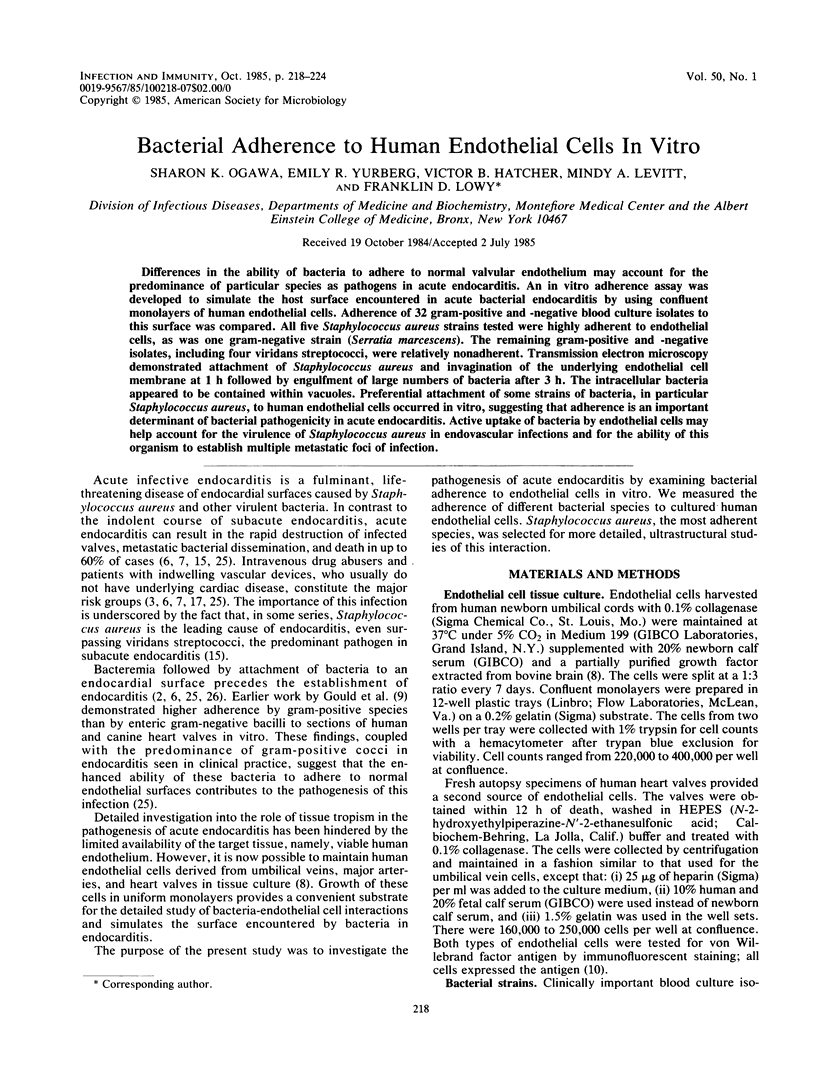
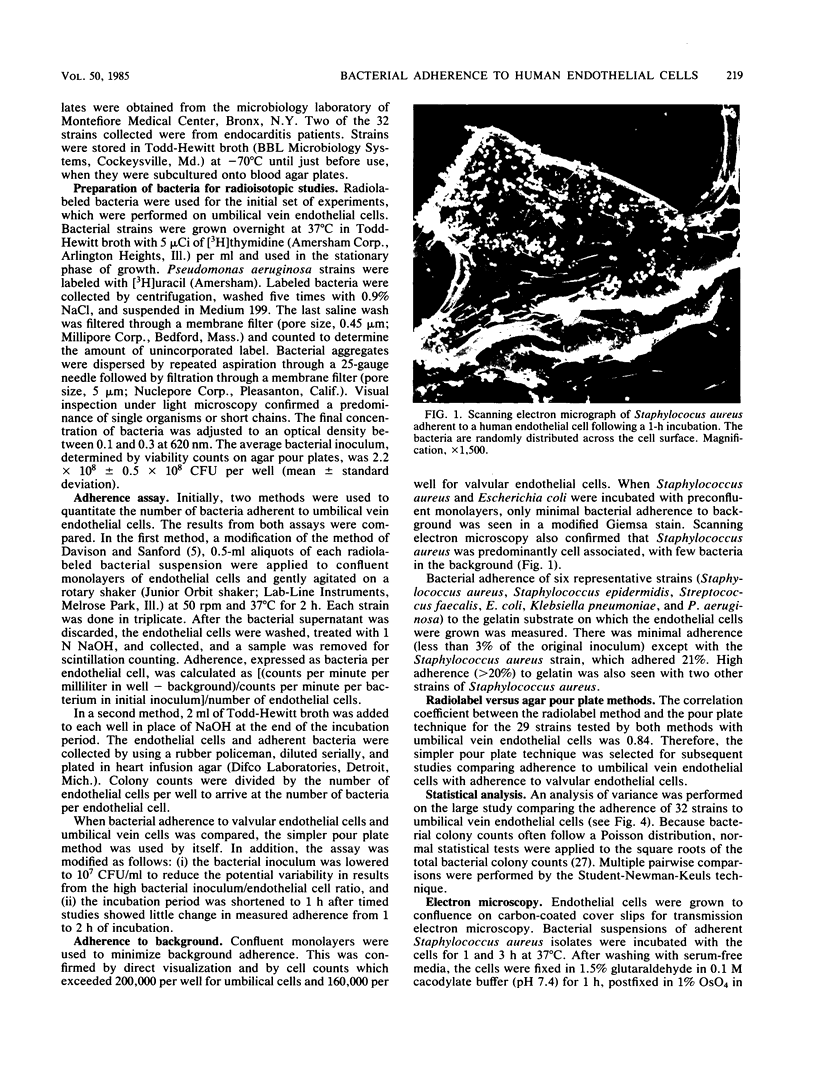
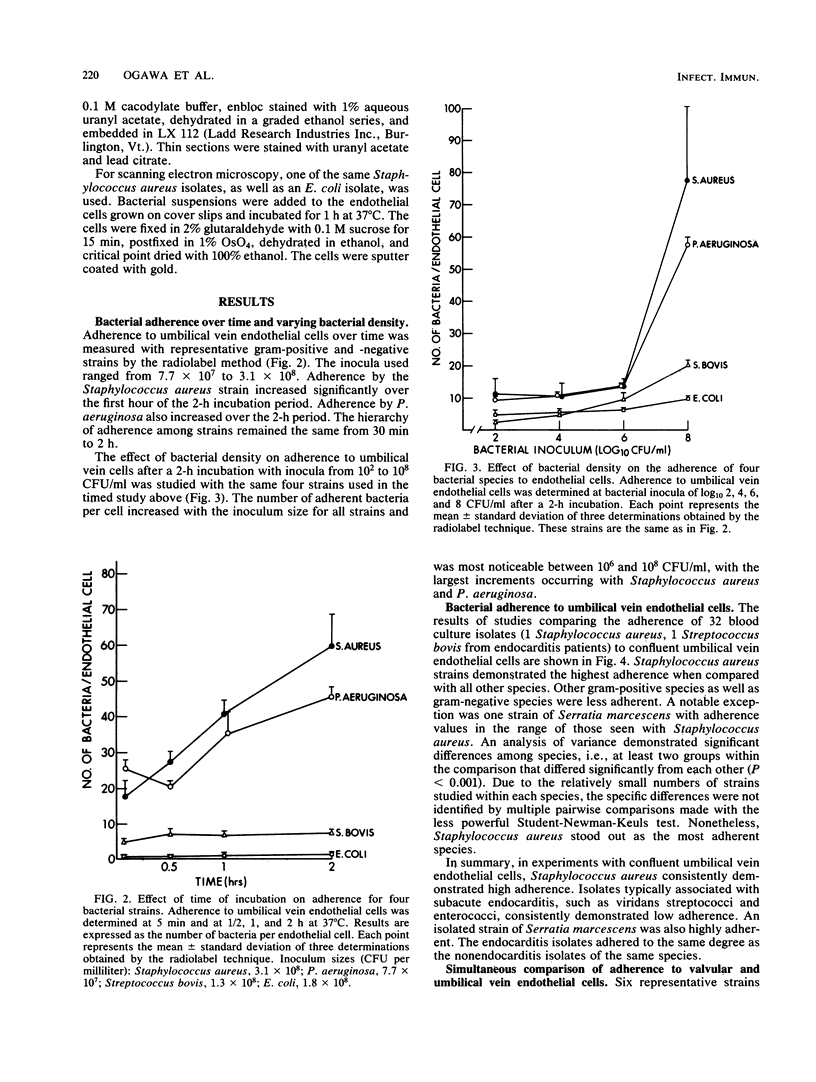
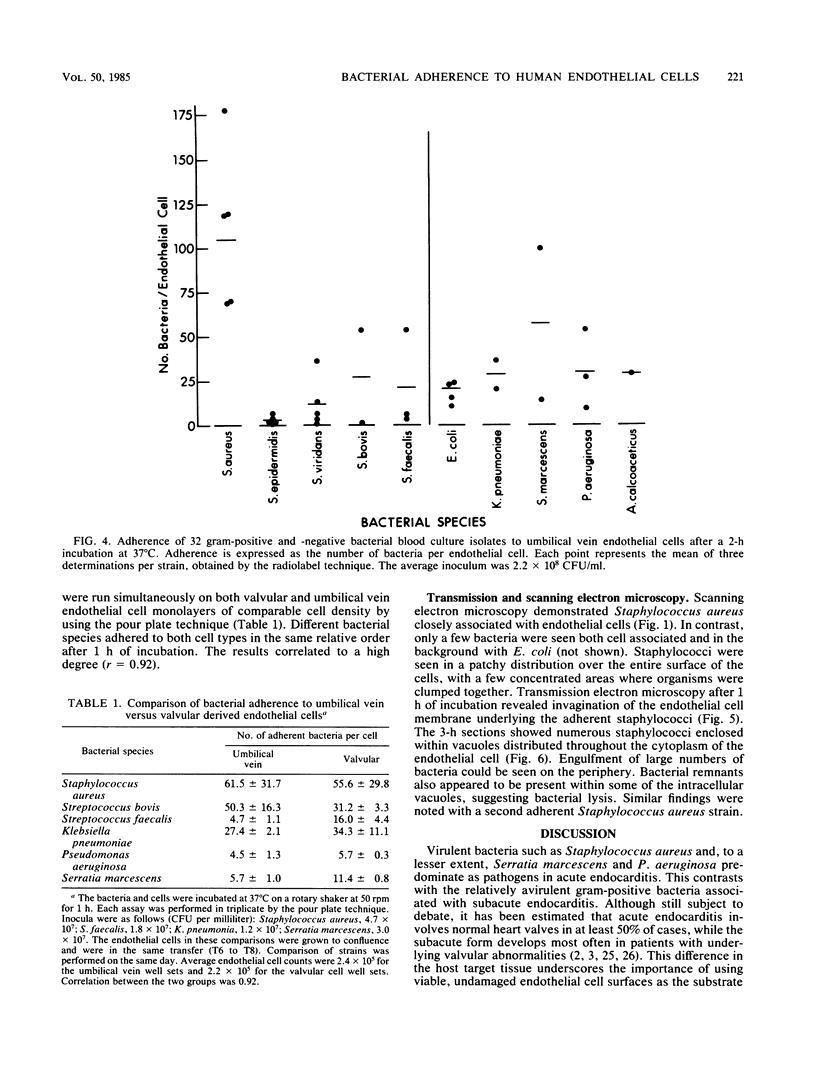
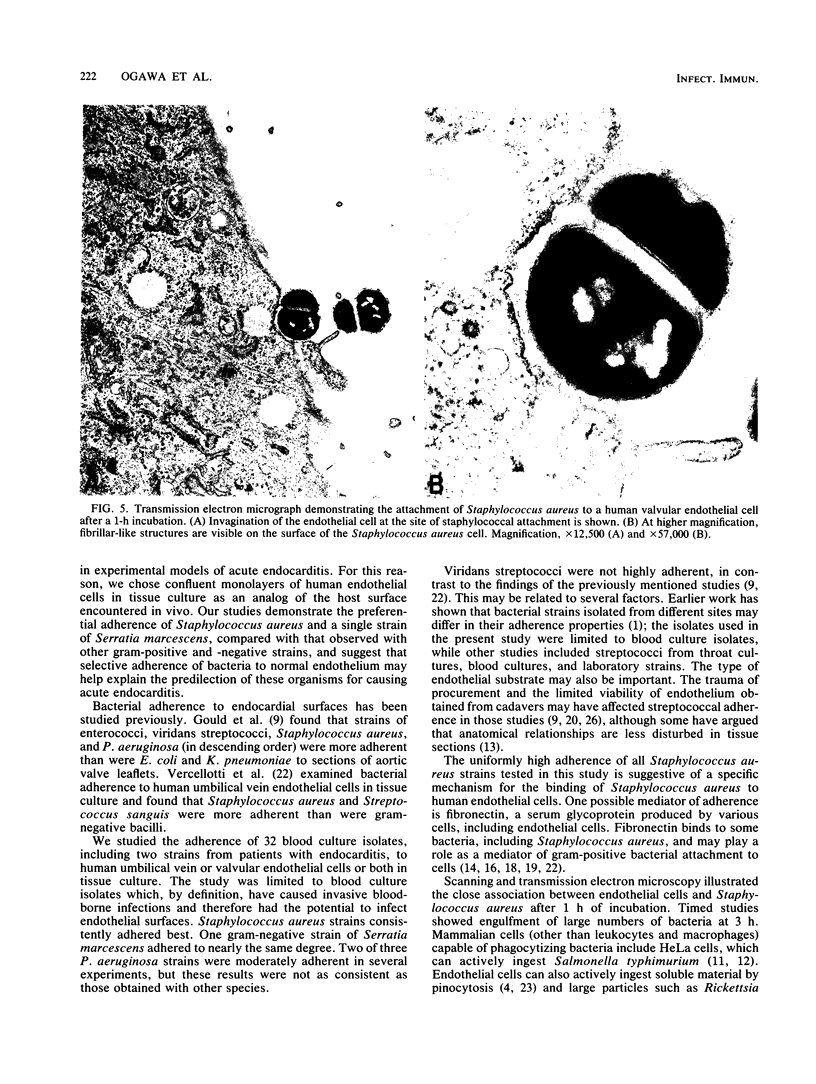

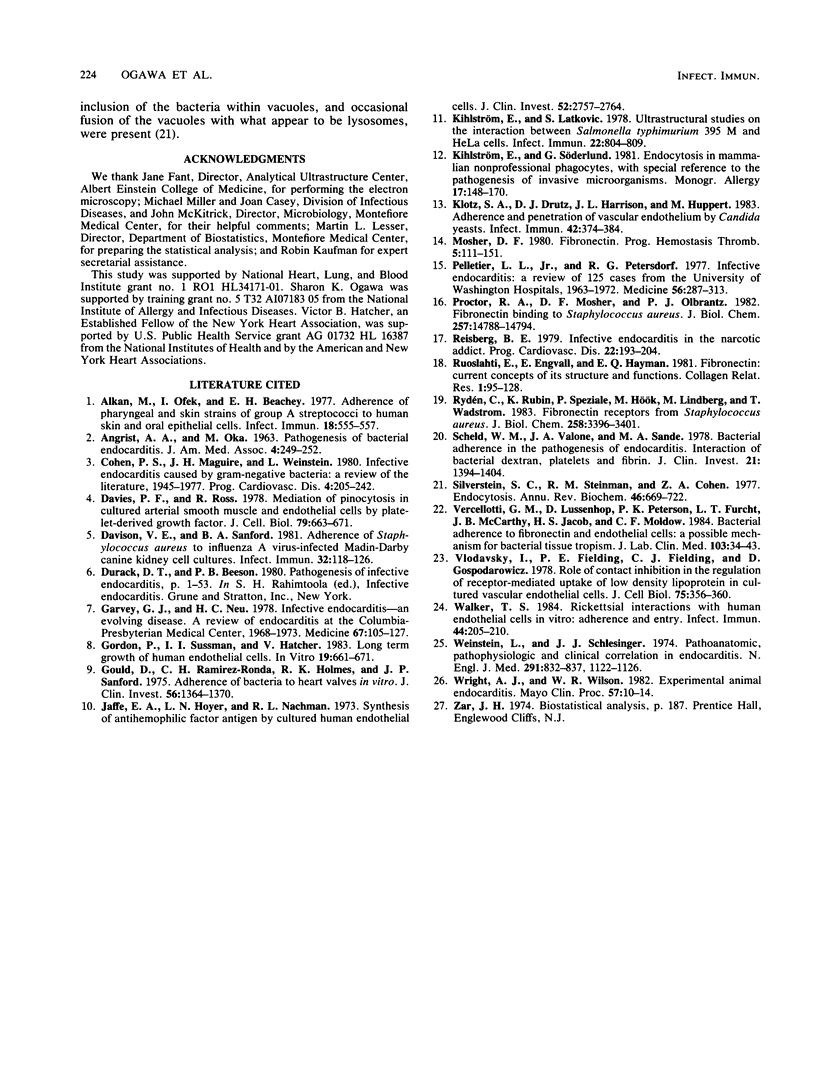
Images in this article
Selected References
These references are in PubMed. This may not be the complete list of references from this article.
- ANGRIST A. A., OKA M. Pathogenesis of bacterial endocarditis. JAMA. 1963 Jan 26;183:249–252. doi: 10.1001/jama.1963.63700040009010b. [DOI] [PubMed] [Google Scholar]
- Alkan M., Ofek I., Beachey E. H. Adherence pharyngeal and skin strains of group A streptococci to human skin and oral epithelial cells. Infect Immun. 1977 Nov;18(2):555–557. doi: 10.1128/iai.18.2.555-557.1977. [DOI] [PMC free article] [PubMed] [Google Scholar]
- Cohen P. S., Maguire J. H., Weinstein L. Infective endocarditis caused by gram-negative bacteria: a review of the literature, 1945-1977. Prog Cardiovasc Dis. 1980 Jan-Feb;22(4):205–242. doi: 10.1016/0033-0620(80)90010-9. [DOI] [PubMed] [Google Scholar]
- Davies P. F., Ross R. Mediation of pinocytosis in cultured arterial smooth muscle and endothelial cells by platelet-derived growth factor. J Cell Biol. 1978 Dec;79(3):663–671. doi: 10.1083/jcb.79.3.663. [DOI] [PMC free article] [PubMed] [Google Scholar]
- Davison V. E., Sanford B. A. Adherence of staphylococcus aureus to influenza A virus-infected Madin-Darby canine kidney cell cultures. Infect Immun. 1981 Apr;32(1):118–126. doi: 10.1128/iai.32.1.118-126.1981. [DOI] [PMC free article] [PubMed] [Google Scholar]
- Garvey G. J., Neu H. C. Infective endocarditis--an evolving disease. A review of endocarditis at the Columbia-Presbyterian Medical Center, 1968-1973. Medicine (Baltimore) 1978 Mar;57(2):105–127. [PubMed] [Google Scholar]
- Gordon P. B., Sussman I. I., Hatcher V. B. Long-term culture of human endothelial cells. In Vitro. 1983 Sep;19(9):661–671. doi: 10.1007/BF02628957. [DOI] [PubMed] [Google Scholar]
- Gould K., Ramirez-Ronda C. H., Holmes R. K., Sanford J. P. Adherence of bacteria to heart valves in vitro. J Clin Invest. 1975 Dec;56(6):1364–1370. doi: 10.1172/JCI108216. [DOI] [PMC free article] [PubMed] [Google Scholar]
- Jaffe E. A., Hoyer L. W., Nachman R. L. Synthesis of antihemophilic factor antigen by cultured human endothelial cells. J Clin Invest. 1973 Nov;52(11):2757–2764. doi: 10.1172/JCI107471. [DOI] [PMC free article] [PubMed] [Google Scholar]
- Kihlström E., Latkovic S. Ultrastructural studies on the interaction between Salmonella typhimurium 395 M and HeLa cells. Infect Immun. 1978 Dec;22(3):804–809. doi: 10.1128/iai.22.3.804-809.1978. [DOI] [PMC free article] [PubMed] [Google Scholar]
- Klotz S. A., Drutz D. J., Harrison J. L., Huppert M. Adherence and penetration of vascular endothelium by Candida yeasts. Infect Immun. 1983 Oct;42(1):374–384. doi: 10.1128/iai.42.1.374-384.1983. [DOI] [PMC free article] [PubMed] [Google Scholar]
- Mosher D. F. Fibronectin. Prog Hemost Thromb. 1980;5:111–151. [PubMed] [Google Scholar]
- Pelletier L. L., Jr, Petersdorf R. G. Infective endocarditis: a review of 125 cases from the University of Washington Hospitals, 1963-72. Medicine (Baltimore) 1977 Jul;56(4):287–313. [PubMed] [Google Scholar]
- Proctor R. A., Mosher D. F., Olbrantz P. J. Fibronectin binding to Staphylococcus aureus. J Biol Chem. 1982 Dec 25;257(24):14788–14794. [PubMed] [Google Scholar]
- Reisberg B. E. Infective endocarditis in the narcotic addict. Prog Cardiovasc Dis. 1979 Nov-Dec;22(3):193–204. doi: 10.1016/0033-0620(79)90023-9. [DOI] [PubMed] [Google Scholar]
- Ruoslahti E., Engvall E., Hayman E. G. Fibronectin: current concepts of its structure and functions. Coll Relat Res. 1981;1(1):95–128. doi: 10.1016/s0174-173x(80)80011-2. [DOI] [PubMed] [Google Scholar]
- Rydén C., Rubin K., Speziale P., Hök M., Lindberg M., Wadström T. Fibronectin receptors from Staphylococcus aureus. J Biol Chem. 1983 Mar 10;258(5):3396–3401. [PubMed] [Google Scholar]
- Scheld W. M., Valone J. A., Sande M. A. Bacterial adherence in the pathogenesis of endocarditis. Interaction of bacterial dextran, platelets, and fibrin. J Clin Invest. 1978 May;61(5):1394–1404. doi: 10.1172/JCI109057. [DOI] [PMC free article] [PubMed] [Google Scholar]
- Silverstein S. C., Steinman R. M., Cohn Z. A. Endocytosis. Annu Rev Biochem. 1977;46:669–722. doi: 10.1146/annurev.bi.46.070177.003321. [DOI] [PubMed] [Google Scholar]
- Vercellotti G. M., Lussenhop D., Peterson P. K., Furcht L. T., McCarthy J. B., Jacob H. S., Moldow C. F. Bacterial adherence to fibronectin and endothelial cells: a possible mechanism for bacterial tissue tropism. J Lab Clin Med. 1984 Jan;103(1):34–43. [PubMed] [Google Scholar]
- Vlodavsky I., Fielding P. E., Fielding C. J., Gospodarowicz D. Role of contact inhibition in the regulation of receptor-mediated uptake of low density lipoprotein in cultured vascular endothelial cells. Proc Natl Acad Sci U S A. 1978 Jan;75(1):356–360. doi: 10.1073/pnas.75.1.356. [DOI] [PMC free article] [PubMed] [Google Scholar]
- Walker T. S. Rickettsial interactions with human endothelial cells in vitro: adherence and entry. Infect Immun. 1984 May;44(2):205–210. doi: 10.1128/iai.44.2.205-210.1984. [DOI] [PMC free article] [PubMed] [Google Scholar]
- Weinstein L., Schlesinger J. J. Pathoanatomic, pathophysiologic and clinical correlations in endocarditis (second of two parts). N Engl J Med. 1974 Nov 21;291(21):1122–1126. doi: 10.1056/NEJM197411212912110. [DOI] [PubMed] [Google Scholar]
- Wright A. J., Wilson W. R. Experimental animal endocarditis. Mayo Clin Proc. 1982 Jan;57(1):10–14. [PubMed] [Google Scholar]





